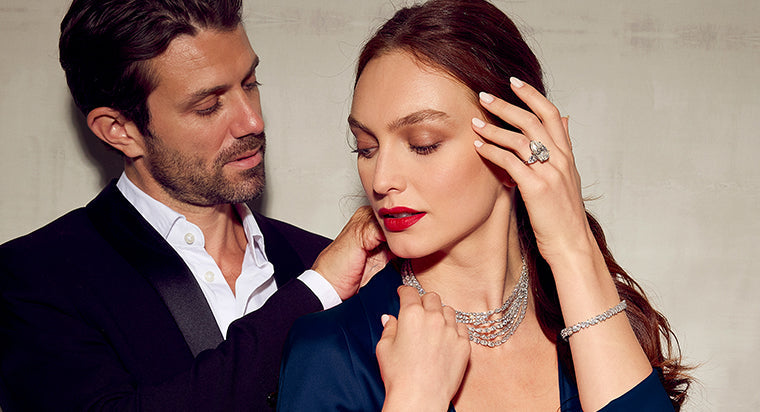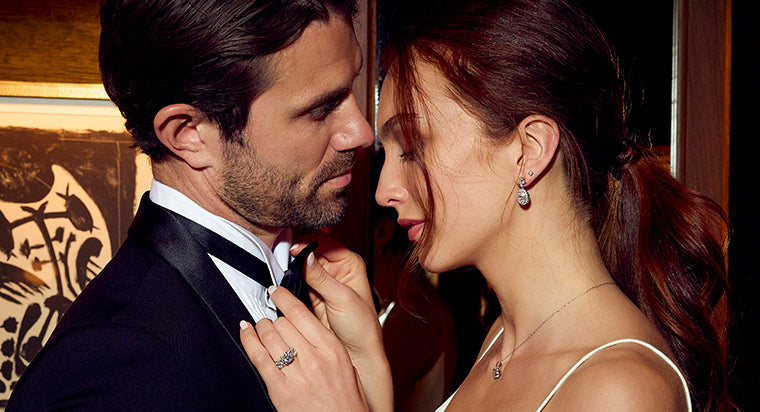Earring Backing Guide

You get back home, glance in the mirror, and panic immediately sets in – you’re missing one of your grandmother’s diamond earrings. It’s an awful feeling that makes you hope that it’s nearby and that you can retrace your steps to find it. Sometimes, you find it and other times, you don’t. One tiny little piece of jewelry helps to prevent you from losing your expensive earrings – your earrings backs. Your jewelry is an investment and likely has sentimental value, so you want to ensure your earring backs keep your valuables safe. Keep reading to learn more about earring back options.
TABLE OF CONTENTS
Types of Earring Backs
To talk about earring backs, we’ll discuss a couple popular earring designs and type of back options.
- Stud Earrings: From diamonds to gemstones and everything in between, stud earrings are a versatile, minimalist earring design that will never go out of style. Studs have an item attached to a post that goes through the ear to the earring back. Here are three commonly used earring backs for studs.
- Push Backs: This style of earring back is a familiar-looking one, and is also known as a friction back. It has a flat back plate with a hole the size of the post. It features two scrolls of metal that curve up and press against the post with a light spring tension to hold the back in place. Push backs come in a variety of sizes, and they’re easy to put on and take off. These are discreet, small earring backs.
- Secure Lock Backs: These earring backs securely lock into place with a double grooved secure locking mechanism. These are also a good option for high-priced studs because the locking mechanism secures them. A unique addition to these backs is the large, plastic disc that rests on the earring. While this helps support the weight of a heavier earring, the disc is more noticeable on smaller ears.
- Screw Backs: This style of earring back is very secure because it cannot be pulled off and has to be screwed off. The post has threads that allow the earring back to screw on and off. The security that these backs offer makes them a good option for high-priced studs. Like the push backs, these are also smaller earring backs.
- Dangle and Hoop Earrings: Dangle and hoop earrings are larger than stud earrings. They’re classic, timeless styles that vary from simple to elaborate. These earrings tend to be heavier than studs, so the needs of the earring backs are different than studs.
- Safety Lock Closures: This type of earring back features a button that locks the closure in place. It works well for heavy or long earrings because they can withstand pressure and weight. The lock button makes these backs highly secure.
- Lever Backs: This style of earring backs are often used for hoops and dangle earrings. Lever backs feature a hinged lever that locks into place. It’s a secure option that is easy to put on and take off. A unique attribute of this back is that they’re meant to be seen. They add some shimmer and move with the wearer more than other earring back styles.
- Secure Lock Backs: These earring backs securely lock into place with a double grooved secure locking mechanism. These are also a good option for high-priced studs because the locking mechanism secures them. A unique addition to these backs is the large, plastic disc that rests on the earring. While this helps support the weight of a heavier earring, the disc is more noticeable on smaller ears.
Like other types of jewelry, you also have metal choices when it comes to earring backs. Earring backs are worn close to the skin, so you’ll want to pick the right metal for your level of skin sensitivity. Popular metal choices for fine jewelry backs include 14kt, 18kt and platinum. The difference between 14kt and 18kt is the percentage of pure gold in the alloys. So 18kt gold contains 75% gold and 14kt gold contains 58.3%. Some are more sensitive to the alloys, so you could choose an 18kt option. The 14kt option is durable and resistant to wear because of the higher amount of alloys. Platinum costs more and is hypoallergenic, but it’s a good option if you are sensitive to gold.
Whether you have diamond studs or diamond hoops, you’ll want an earring back that protects your valuables and gives you a sense of security as you wear your earrings out and about.
FAQs
Can you change the backing of an earring?
Jewelers can convert earrings from one type to another. For example, if you decide you’d rather have a screw back than a push back, a jeweler can make the switch.
Do silicone earring backs work?
Silicone earring backs use squishy material to cling to the post. While they do work, they are more noticeable than other backs.
Which is the most common earring backing?
Push back earrings are the most common. This type of backing slides onto the post to secure the earring against your lobe. They feature two scrolls of metal that curve up and press against the post with a light spring tension to hold the back in place.
Do screw back earrings hurt?
Screw back earrings do not hurt – they’re light, comfortable and made with high-quality metal so they won’t react with your skin.









